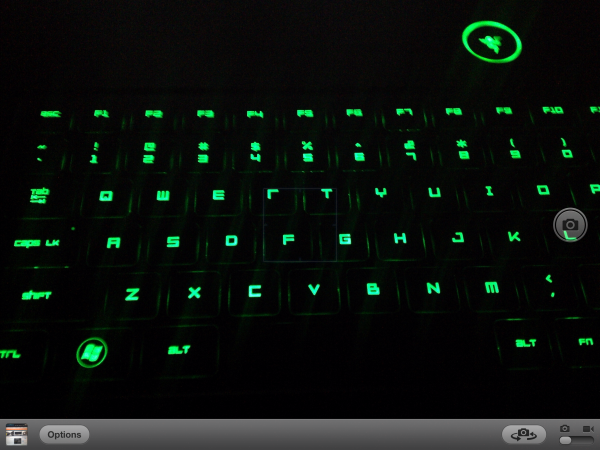The Apple iPad Review (2012)
by Vivek Gowri & Anand Lal Shimpi on March 28, 2012 3:14 PM ESTThe Camera, It's Much Improved
by Vivek Gowri
iOS 5.1 brought with it a number of bugfixes along with a few minor changes to the core entertainment applications (Music, Photos, Videos), but the only real UI change it brought was the redesigned camera application for the iPad. It fixes our biggest complaint with the original—the shutter button’s location in the middle of the settings bar at the bottom of the screen—and ends up being a big improvement from a usability standpoint. The shutter now resides in a floating circular button on the right side of the display, right where your right thumb falls when holding the iPad with two hands. It’s a more intuitive location for the shutter, so taking a picture is a far more natural feeling exercise than it was before. Other than that, the app looks pretty similar—the settings bar now has the still/video slider, front/rear camera switch, an options button, and the link to the photo gallery.
In terms of camera options, there’s only one. You can either have the rule of thirds grid overlay visible or hidden....and that’s it. There’s no other settings for you to change. No exposure, white balance, ISO, shutter speed, or anything else that isn’t the shutter button. Unfortunately, even the HDR mode from the 4 and 4S is nowhere to be found on the iPad. You literally just point and shoot. That’s all there is for you to do.
In our review of the iPad 2, we summed up the cameras with just one word, mediocre. Looking back, I realize now that the word mediocre is a pretty charitable way to describe the iPad 2’s camera situation. Both sensors were borrowed from the iPod touch, and while the VGA front facing camera was acceptable, the rear facing 720p camera was legitimately bad by the standards of a $499 device.
The new iPad fixes that rear camera problem in a big way, with the five element f/2.4 lens and optics borrowed from the iPhone 4S paired with the Omnivision OV5650 CMOS image sensor from the iPhone 4. A quick refresher on specs: 5 megapixels, backside illuminated, 1080p video at 60fps. If you ignore megapixel count, it’s a pretty competitive camera on paper. There’s a lot of recycled parts here, with bits and pieces from other iDevices frankensteined together to come up with a new imaging system for the iPad, but parts-bin raids aren’t bad when the bins being raided from contain top-tier components. The result ends up being pretty good—as a camera, the new iPad is light years ahead of its predecessor in basically every way.
In practice, it’s nothing short of stellar. Image quality is comparable to most high end smartphones, though not quite good enough to be on par with the bleeding edge cameraphones (4S, Nokia N8/N9, HTC Amaze 4G, Galaxy S 2, etc). Interestingly enough, the preview image looks to be running below 30 fps, appearing a little bit choppy at times. This is likely due to the high resolution of the preview and upscaling it to a very high display resolution, but it doesn’t particularly affect image capture. I measured shot to shot time at exactly one second (I had a range between 0.98 and 1.04 seconds, averaged out to 1.0 when factoring in reaction time). That’s about double what Apple claimed for the 4S, and a bit longer than the iPad 2. Granted, the iPad 2’s camera was very quick in part because the amount of processing it takes to capture a 960x720 image is almost zero, with about 13.8% as many pixels as each 2592x1936 image captured by the new iPad.
The focal length is 4.28mm, a bit longer than the iPad 2’s 3.85mm. The difference is actually noticeable; when taking pictures of nearby subjects, you’re sometimes surprised by how magnified the subject appears. However, the camera is good for landscapes, as you can see from the sample gallery. I took the iPad with me on a weekend trip to Victoria, B.C. and used it as my primary camera on the trip. Now, while I wouldn’t trade my SLR for an iPad anytime soon, I can’t deny that the results turned out pretty well. Colours were vibrant, white balance was accurate, and the clouds were nicely highlighted. It’s a quantum leap from the noisy, 0.7MP mess that was the iPad 2 camera. Mouse over the links below to see some comparisons between the cameras on the iPad 2, 3rd gen iPad and TF Prime.

| Apple iPad 2 | Apple iPad (3rd gen) | ASUS TF Prime |
| original | original | original |

| Apple iPad 2 | Apple iPad (3rd gen) | ASUS TF Prime |
| original | original | original |
The new sensor can record 1080p video, up from 720p. Video quality was probably the best aspect of the iPad 2 camera, and it's even better here. Output is recorded at 29.970 fps and encoded in h.264 Baseline with a bitrate of 21Mbps and single channel audio at 64kbps. The recorded video impresses, with crisp detailing and adequate audio quality from the single mic.
The front facing camera keeps the Omnivision OV297AA sensor from the iPad 2, and as such, image and video quality remain unchanged. It’s not necessarily a bad thing, since it remains adequate for FaceTime and Skype, but it would have been nice to see an update to an HD-quality webcam up front.
With augmented reality apps, I’m starting to see the benefit of rear cameras on tablets. For example, the Yelp app, which takes location and compass data to display what restaurants are the direction the iPad is pointing, with a real-time street view of the search results. It’s not necessarily the most useful way to use the rear facing camera in an AR application, but overall it’s an idea that has potential. Apple also tells us that its business and education customers see usefulness in the iPad's rear facing camera as they can use it to quickly document something while using the iPad as a productivity tool. As a consumer, you’re going to get weird looks if you’re using the iPad to take pictures though, it’s a relatively comical sight.
And that’s really the problem: from an ergonomic standpoint, smartphones are just so much easier and more comfortable to use as cameras. And because the imaging hardware is so similar, I’m not sure I see the real benefit of having a rear facing camera on a tablet except in very specific use cases.

























234 Comments
View All Comments
vol7ron - Thursday, March 29, 2012 - link
Think you meant "except" :)adityarjun - Friday, March 30, 2012 - link
No, you aren'tsiddharth7 - Friday, March 30, 2012 - link
Yeah! Kind of a typo :). Also forgot the question mark. :-)Wanted to edit it, but was not able to after posting. :)
Xyraxx - Thursday, March 29, 2012 - link
Ok, gaming clearly the TF came out ahead. Why the backhanded commentary in that section? I don't see that for the sections that the iPad clearly won. TF takes the overall top spot for its gaming performance. But instead of commentary on that, we get aggressive talk about how they should be pushing even further ahead, and how they are failing at it.The controller compatibility is an absolute win for the Android side, but instead of talk about that, we get this "Yeah, but who says controllers will win over touch". Its like every advantage the iPad doesn't win over, gets trotted out and downplayed as if to say it doesn't mean anything, or somehow doesn't matter.
darkcrayon - Thursday, March 29, 2012 - link
Interesting. I got a different impression entirely. It seems like games specifically optimized for the Tegra 3 by nVidia were somewhat better visuallyr, but the iPad has a more extensive game library and considering the GPU is far more powerful than the Tegra 3's, it's only a matter of time before there are far better graphics to be had on iPad games.Though there is no OS level controller support in iOS, both Bluetooth and dock connector controllers are possible (hence the iControlpad iCade, and a few others). It may be that more games support them now on Android, but nothing is stopping developers from supporting them on iOS at this point.
Finally, it's pretty important that ~100% of the iPad games in the App Store will run on the new iPad, which can't be said for the TF as shown in the review, or probably for any other individual Android tablet.
mr_ripley - Thursday, March 29, 2012 - link
It seems to me that the iPad does charge when I plug it into the USB port on my Macbook Pro. In fact I was surprised to see that not only did it not say "not charging" and show the "plugged-in" icon, it also seemed pretty fast (I will have to try it again to see if it was as fast as the power charger).However, when I tried to this morning to plug it into my Lenovo laptop it showed "not charging". Does this only work when plugged into Apple products?
vol7ron - Thursday, March 29, 2012 - link
This question seems better suited for the Apple support forums.doobydoo - Sunday, April 1, 2012 - link
This reply seems better suited to the kids-r-us forum.Aenean144 - Thursday, March 29, 2012 - link
Modern Macs have special USB hubs that output 7 to 8 Watts of power (~5V at ~1.6A). Most Windows machines or non-Macs and older Macs output about 4.5 Watts max. There's a USB battery charging specification, but I'm not aware of any computers that have this implemented.So, most Mac should be able to charge an iPod, iPad, iPhone relatively quickly. A PC with the normal USB specs will typically do it a little bit slower. 40 to 50%. 4.5 Watts is basically the bare minimum. Doable on an iPad 2 with the screen off, but the 2012 iPad will be tough. If you have the screen off, turn off WiFi and Bluetooth, it'll charge ok if Apple lets it. The screen has to be off with 4 Watt power source.
mr_ripley - Thursday, March 29, 2012 - link
Ah ha! Thanks for the clarification. When I saw that I was able to charge my new ipad while using it with my Macbook pro USB, I neglected to bring along my charger to work. Seems like that was unwise.But I still have around 50% power left so should be fine for today. And yes I do use it at work.